Handling of the navel of the newborn cause concern? To be more confident in yourself young mother will help the information from the article.
Contents of
- How does the navel look like in a newborn?
- VIDEO: Care of the umbilical wound of the newborn
- When the navel falls off the newborn?
- When does the navel heal the newborn?
- How many times is the navel treated in a newborn? How correctly to process a navel at the newborn?
- Why does the navel have a navel in the newborn? What to do?
- Why does the navel of a newborn get wet? What to do?
- Than to smear a navel at the newborn?
- VIDEO: What is the best way to process a newborn's navel?- Dr. Komarovsky
Treatment of umbilical wound is the first mandatory procedure, which the young mother must learn in the maternity hospital. In some women, it causes fear and insecurity, because the newborn is still so small and fragile.
To panic and get lost is not necessary, usually, in manipulations with the navel is not anything difficult. If it happens that the umbilical wound will begin to cover or become wet, along with the pediatrician it will be possible to solve this extra-ordinary situation.
How does the navel look like in a newborn?
During pregnancy, fetus and mother organisms are inextricably linked by the umbilical cord. Through this smooth and elastic cord 50-70 cm in length the child breathes and feeds.
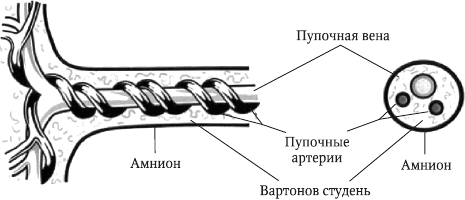 The structure of the umbilical cord.
The structure of the umbilical cord. At the time of delivery, the umbilical cord consists of:
- of the umbilical arteries( these vessels are two pieces) of the umbilical vein
- ( through it the blood enriched with oxygen and nutrients gets to the fetus)
- varton jelly( its function is the umbilical cord protection)
childbirth under the influence of the hormone oxytocin, which reacts vartonov jelly, umbilical vessels narrow, begins atrophy of the umbilical cord.
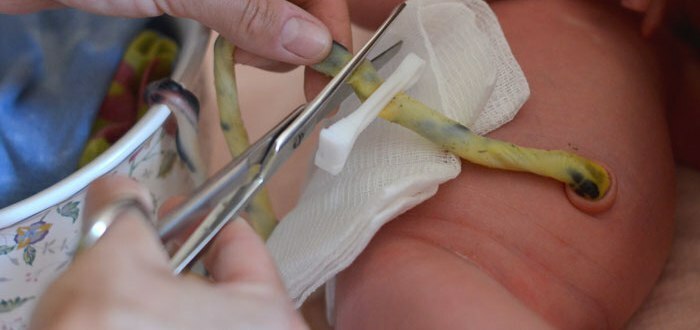 Cutting the umbilical cord.
Cutting the umbilical cord. But when the baby is born, the function of the placenta has not yet been lost, the umbilical cord is pulsing, and the baby still breathes through it and receives the remains of nutrients. For a time, seconds or minutes, the newborn is on the so-called double breath - he receives oxygen through the umbilical cord and through his own breathing organs.
IMPORTANT: Doctors lead heated discussions about when it is better to cut the umbilical cord, finally separating the baby from the mother. Some believe that it should be done immediately after birth, others - at a time when the umbilical vessels will cease to pulsate. Each side has its own arguments. But in both cases the process is carried out in the same sequence
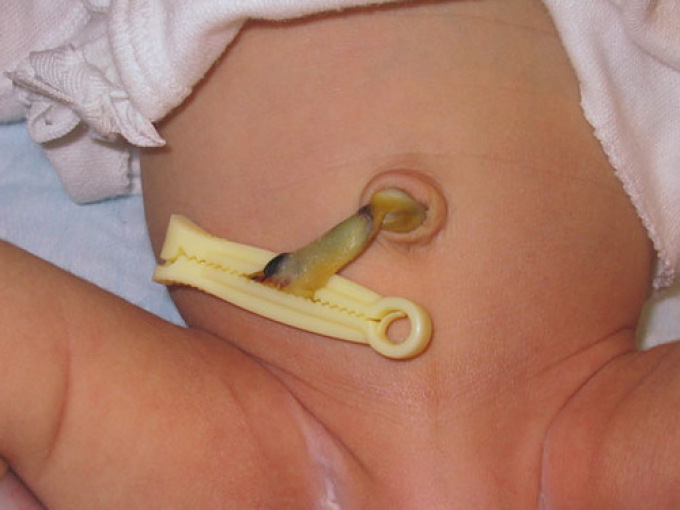 Navel with a stump in the newborn.
Navel with a stump in the newborn. Observing the rules of asepsis and antiseptics, the doctor sets a special clamp on the placenta about 2 cm from the tummy of the newborn, and then cuts the umbilical cord. The remainder of the umbilical cord is first treated with alcohol in the rod.
On the tummy of the baby there is a small tail that will soon atrophy, dry and fall off. And if the mother is able to provide the umbilical wound with the proper care, in the future the baby will have a neat little umbilical.
VIDEO: Care of the umbilical wound of the newborn
When the navel falls off the newborn?
Children's end of the umbilical cord( stump) falls off 2 to 14 days after the birth of the child. This should happen spontaneously.
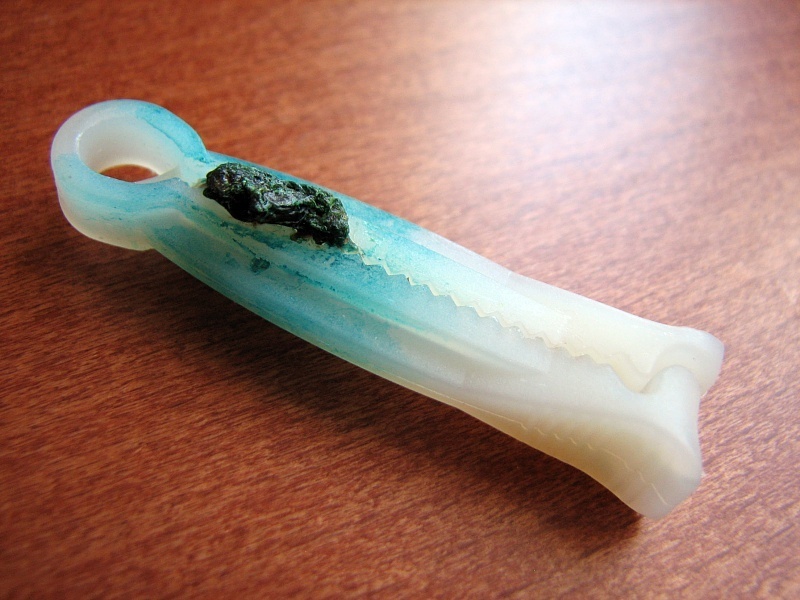 The navel of the newborn falls off for 2-14 days of life.
The navel of the newborn falls off for 2-14 days of life. IMPORTANT: Previously, women were in the maternity hospitals for 7-8 days, or until the umbilical stump disappears. It's no secret that doctors often "contributed" to this event by removing the remains of the umbilical cord with scissors or a scalpel. Such actions, they endanger the health of the baby
To promote the fallout of the umbilical cord in any case impossible:
- If this happens until the vessels are completely mummified, the navel in the form of an open wound will become the "entrance door" for getting into the baby's body of all kinds of infections.
- cases in which the umbilical cord gets into the bowel. You can not talk about the consequences that will occur if it is cut off
Today young mothers and newborns, if they are all right, are discharged on the third day after delivery. Therefore, in most cases, the umbilical stump in toddlers is no longer at home.
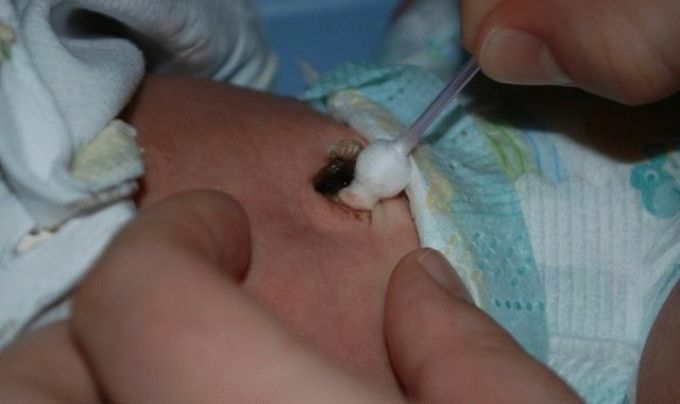 How to treat the navel a woman should be instructed in the hospital.
How to treat the navel a woman should be instructed in the hospital. Before discharge, nurses should instruct the woman what care she should provide for the baby's belly button. The same must be told to her by a pediatrician or a visiting nurse who will visit her at home in the first days.
IMPORTANT: Before the baby ends the baby's cord, it is better to wear special diaper for the newborn with a cutout for the navel.
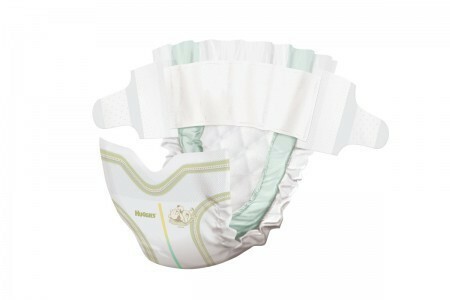 A diaper for the newborn with a cutout for the navel.
A diaper for the newborn with a cutout for the navel. When does the navel heal the newborn?
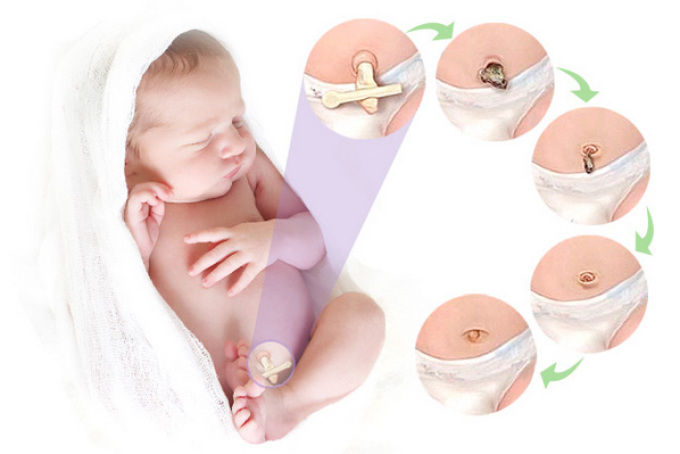 Stages of navel healing.
Stages of navel healing. Normally, the umbilical wound in a child should heal 2-3 weeks after the stump has fallen off, or by the end of the first month of life.
How many times is the navel treated in a newborn? How correctly to process a navel at the newborn?
The rules of caring for the umbilical wound, manipulations that promote its healing, are simple. Young mothers very quickly master them, bring their actions to automatism.
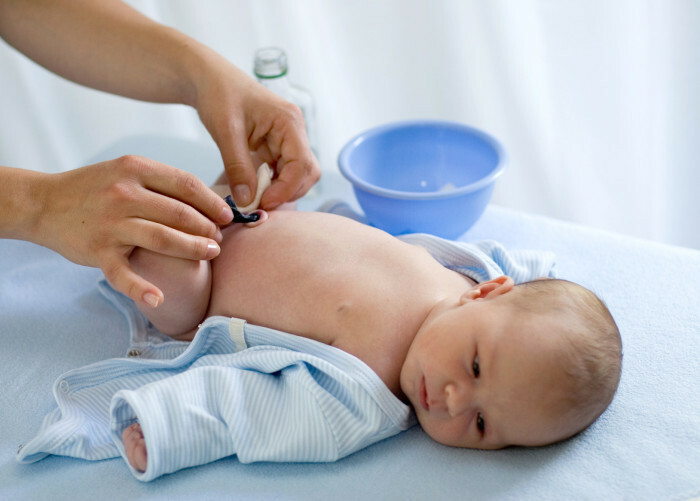 Handling of the navel is a daily procedure for the baby in the first month of his life.
Handling of the navel is a daily procedure for the baby in the first month of his life. So, in order for the umbilical wound of the crumbs to heal safely and quickly, the parents should:
- Give the body a baby to breathe. The possibility of conducting air baths and their duration largely depends on the temperature conditions of the house and the reaction of the baby to such procedures. If the room is more than 20 degrees, five-minute air baths can be done 3 times a day or after each diaper change. In summer, the duration of the procedure can be 20 minutes - half an hour
- Dry the navel with perhydrol and lubricate with greenery. It is believed that this should only be done if, after the stump disappears inside the umbilical ring, the baby has a crust of caked blood. But doctors often recommend this procedure for preventive purposes for 2 weeks after the umbilical stump has fallen off. Each time after changing the diaper, the mother takes a pipet of hydrogen peroxide and drips a few drops inside the baby's umbilical ring, then dabs it with a sterile bandage. Next, the navel is treated with a cotton swab dipped in green
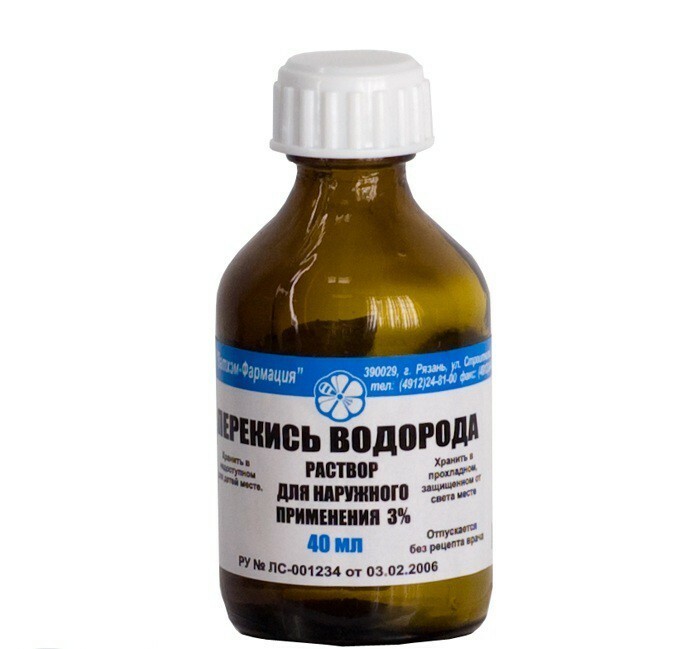 Hydrogen peroxide removes a crust of dried blood on the navel of the newborn.
Hydrogen peroxide removes a crust of dried blood on the navel of the newborn. - Put the child in clothes made of natural fabric. Synthetics can lead to rubbing the navel area or the appearance of
- in it. To bathe a child. Water procedures during the healing of the umbilical wound are by no means contraindicated. You can arrange a bathing baby from the first days of his life. To the wound in place of the dropped cord, the infection did not get, for water procedures for the newborn you need to use boiled water. You can add decoctions of herbs with drying and antiseptic properties to it, if there are no contraindications to their use.
IMPORTANT: If the mother noticed that the navel of the baby is healing too long, it is inflamed or it is bloodied, seals appear in its area, it is necessary to call the pediatrician
. Whyis the navel in the newborn? What to do?
If the first few days after the fall of the stump of the navel, the baby is bleeding a little, there is nothing wrong. There is a natural process of wound healing. If it continues to heal in 7 days and longer, this condition is pathological, formed for such reasons:
- Thick placenta and umbilical cord. In this case, the healing is slower
- Mechanical damage. A crust on the umbilical ring can be removed by negligence during dressing, bathing, handling of the navel. The kid himself can tear it off while lying on his tummy. The crust can also peel off due to friction about the diaper
- An umbilical wound has got an infection. Mom should be alerted by the unpleasant odor of the syucco released from the navel, the presence of purulent discharge, reddening and hyperemia of the skin around the umbilical ring, a fever in the baby, a general deterioration in his condition. In crumbs there may be a purulent omphalitis - an infectious inflammation of the bottom of the umbilical wound
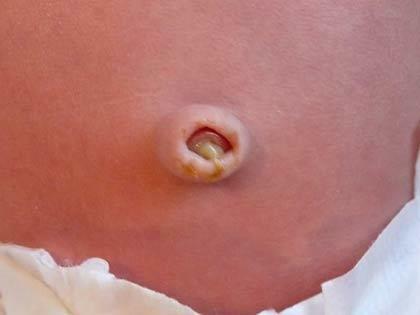 . Pus in the navel of the baby is a sign of infection.
. Pus in the navel of the baby is a sign of infection. - Umbilical hernia. True to her sign - during crying, coughing, other physical effort, the baby's navel is bulged and increases to the size of a walnut
IMPORTANT: Sometimes, in order for the navel to cease to be covered, it is enough for the mother to change the tactics of caring for him. But there are cases when a child needs qualified medical care. Therefore, if the blood is released from the umbilical wound for longer than 5-7 days, the toddler needs to be shown to the doctor
Why does the navel become wet in the newborn? What to do?
- If there are serous discharges from the umbilical wound, it is said that the navel can become wet
- This can occur for the same reasons that the wound in place of the decayed umbilical stump is covered by
- . The collapsing navel must also be treated, otherwise serous discharge will create a favorable environment formultiplication of microorganisms causing disease
How to smear a navel in a newborn?
The pharmacy has a mass of tools for processing the navel of the newborn. For preventive purposes apply:
- solution with brilliant green
- potassium permanganate
- decoction of turn
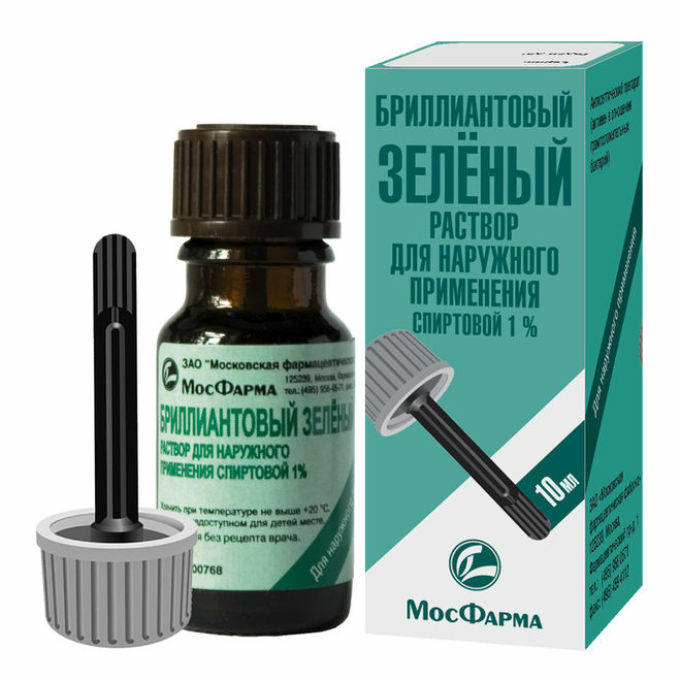 Zelenka is a classic tool for processing the navel.
Zelenka is a classic tool for processing the navel. To ensure that the umbilical cord is not closed due to infection, use:
- chlorophylliptine solution
- with ethanol
- with local antibiotic baneocin
- with other drugs prescribed by the doctor
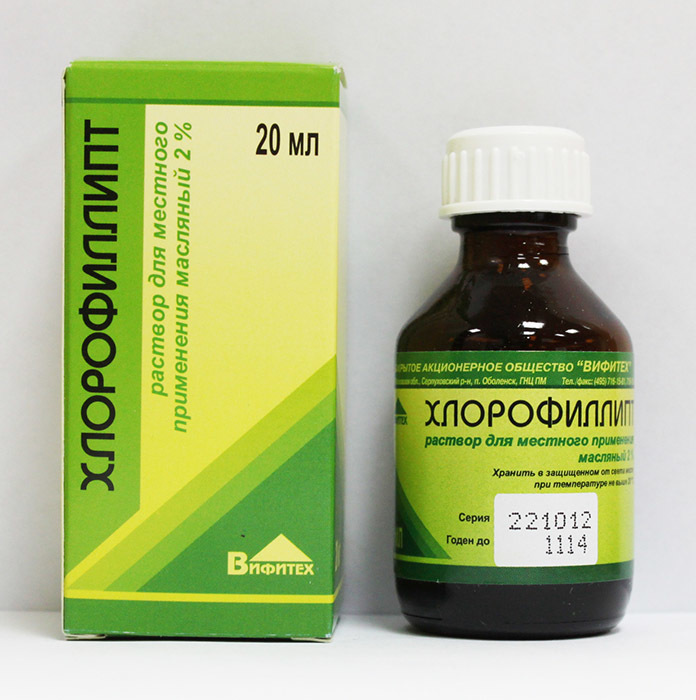 Chlorophyllipt is an antiseptic for umbilical wound treatment.
Chlorophyllipt is an antiseptic for umbilical wound treatment. 